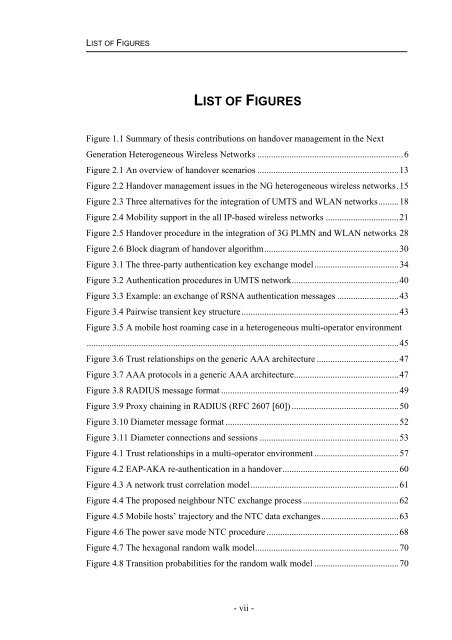Handover mechanisms in next generation heterogeneous wireless ...
Handover mechanisms in next generation heterogeneous wireless ...
Handover mechanisms in next generation heterogeneous wireless ...
Create successful ePaper yourself
Turn your PDF publications into a flip-book with our unique Google optimized e-Paper software.
LIST OF FIGURES<br />
LIST OF FIGURES<br />
Figure 1.1 Summary of thesis contributions on handover management <strong>in</strong> the Next<br />
Generation Heterogeneous Wireless Networks ................................................................ 6<br />
Figure 2.1 An overview of handover scenarios .............................................................. 13<br />
Figure 2.2 <strong>Handover</strong> management issues <strong>in</strong> the NG <strong>heterogeneous</strong> <strong>wireless</strong> networks . 15<br />
Figure 2.3 Three alternatives for the <strong>in</strong>tegration of UMTS and WLAN networks ......... 18<br />
Figure 2.4 Mobility support <strong>in</strong> the all IP-based <strong>wireless</strong> networks ................................ 21<br />
Figure 2.5 <strong>Handover</strong> procedure <strong>in</strong> the <strong>in</strong>tegration of 3G PLMN and WLAN networks 28<br />
Figure 2.6 Block diagram of handover algorithm ........................................................... 30<br />
Figure 3.1 The three-party authentication key exchange model ..................................... 34<br />
Figure 3.2 Authentication procedures <strong>in</strong> UMTS network ............................................... 40<br />
Figure 3.3 Example: an exchange of RSNA authentication messages ........................... 43<br />
Figure 3.4 Pairwise transient key structure ..................................................................... 43<br />
Figure 3.5 A mobile host roam<strong>in</strong>g case <strong>in</strong> a <strong>heterogeneous</strong> multi-operator environment<br />
......................................................................................................................................... 45<br />
Figure 3.6 Trust relationships on the generic AAA architecture .................................... 47<br />
Figure 3.7 AAA protocols <strong>in</strong> a generic AAA architecture.............................................. 47<br />
Figure 3.8 RADIUS message format .............................................................................. 49<br />
Figure 3.9 Proxy cha<strong>in</strong><strong>in</strong>g <strong>in</strong> RADIUS (RFC 2607 [60]) ............................................... 50<br />
Figure 3.10 Diameter message format ............................................................................ 52<br />
Figure 3.11 Diameter connections and sessions ............................................................. 53<br />
Figure 4.1 Trust relationships <strong>in</strong> a multi-operator environment ..................................... 57<br />
Figure 4.2 EAP-AKA re-authentication <strong>in</strong> a handover ................................................... 60<br />
Figure 4.3 A network trust correlation model ................................................................. 61<br />
Figure 4.4 The proposed neighbour NTC exchange process .......................................... 62<br />
Figure 4.5 Mobile hosts’ trajectory and the NTC data exchanges .................................. 63<br />
Figure 4.6 The power save mode NTC procedure .......................................................... 68<br />
Figure 4.7 The hexagonal random walk model ............................................................... 70<br />
Figure 4.8 Transition probabilities for the random walk model ..................................... 70<br />
- vii -












